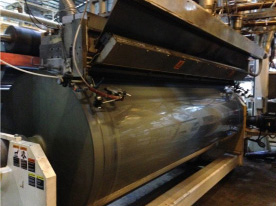Malaysian Plastics Industry Update: January 2015
- Published: January 30, 2015
I’m writing this blog from Kuala Lumpur, Malaysia, where I have been for two weeks conducting training at various companies in Malaysia. All I can is “WOW.”
Industry is booming here. Buildings are being erected everywhere, in every city I visited. There are factories everywhere too. . . BIG factories, employing hundreds, if not thousands of people. Companies here do not specialize the way we do in the USA, but rather have many different technologies within a factory, such as blown film, cast film, extrusion coating & laminating, and printing. In the US, only the biggest companies might have these technologies under one roof, whereas in Malaysia, it is quite common.
The technological level within companies varies, with half the companies employing old Asian equipment, and the other half using modern American and European equipment. The ones with the old equipment do the best they can, but due to productivity requirements by management, quite often they operate that equipment outside of its designed operating range, and thus produce less than optimal quality. The ones using modern equipment compete with the best in America and Europe, operating at world class speeds, efficiencies, and quality. Interestingly enough, those companies with modern equipment from Europe and the USA, have mothballed the Asian equipment (typically Chinese and Indian, to be specific). To be clear and objective, Japanese and Korean equipment is on par with American and European equipment.
 One thing that Malaysian companies seem to lack is skilled engineers on staff. The good thing is that the managing directors recognize this, and they are doing something about it, which is why I am here. Training is a big focus with Malaysian companies—those with modern equipment and those with outdated equipment.
One thing that Malaysian companies seem to lack is skilled engineers on staff. The good thing is that the managing directors recognize this, and they are doing something about it, which is why I am here. Training is a big focus with Malaysian companies—those with modern equipment and those with outdated equipment.
In the last two weeks, I trained about 75 students at four different companies on the topics of blown film, cast film, cast sheet, extrusion coating, and extrusion laminating. In this regard, I think Malaysia—and all of Southeast Asia for that matter—are ahead of the USA. They recognize the need for improved skill sets and ongoing training. Their problems and concerns are not unique, as I have seen them all around the world. The difference is that they address them in an attempt to improve their operations and competitiveness. Perhaps it’s because of the entrepreneurial spirit here versus the corporate structure and mentality in the First World.
Shown first (above) is a cast stretch film line in Southern Malaysia running at 450 m/min with very good efficiency and quality.
 Second is a picture of the same line using infrared photography to observe any potential indications of thermal issues. The "frost line" looks quite uniform, and the line runs very well.
Second is a picture of the same line using infrared photography to observe any potential indications of thermal issues. The "frost line" looks quite uniform, and the line runs very well.
The take-away from all this is that there are major competitive forces in the world that must be addressed. This competition comes not only from low-cost labor but also from equivalent technology and a skilled labor force.


